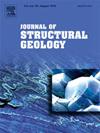用x射线微层析成像研究实验变形岩盐的粒间损伤:围压和盐水效应
IF 2.9
2区 地球科学
Q2 GEOSCIENCES, MULTIDISCIPLINARY
引用次数: 0
摘要
我们使用原位x射线微计算机断层扫描(XR-μCT)研究了合成岩盐在压缩试验中的力学行为。样品在适应x射线断层成像的x射线半透明三轴细胞中在控制应变速率下变形。我们感兴趣的是微损伤的发展与应力状态和盐水的存在或不存在有关。为此,我们在œdometric细胞中通过粉末压实生产了两种不同水量的材料。一种被认为是“实验室干燥”,另一种被认为是“水饱和”。两种材料的平均晶粒尺寸相似(约200 μm)。两种试样分别在单轴和三轴条件下(围压为15 MPa)、室温和恒定位移速率(1 μm/s)下进行变形。结果表明,弥漫性晶间微裂纹的逐渐发展是主要的损伤机制。这可以解释为NaCl的晶体塑性具有很强的各向异性,导致多晶岩盐中相邻晶粒之间存在局部塑性应变不相容。相反,围压和盐水的存在会大大降低微裂纹损伤的发展。含晶间卤水的天然莱茵岩盐样品和在相似条件下的测试结果显示出相似的颗粒间微损伤趋势。我们认为,由于卤水的溶解-沉淀过程抑制或延缓了颗粒间微裂纹的发展,这除了众所周知的愈合作用外,还可能减少局部塑性应变不相容。本文章由计算机程序翻译,如有差异,请以英文原文为准。
Inter-granular damage in experimentally deformed rock-salt investigated by X-ray micro-tomography: confining pressure and brine effects
We have investigated the mechanical behaviour of synthetic rock-salt during compression tests using in situ X-ray micro computed tomography (XR-μCT). Samples were deformed under controlled strain rate in an X-ray semi-transparent triaxial cell adapted to X-ray tomography.
We were interested in the development of micro damage in relation to the stress state and the presence or absence of brine. For that purpose, we produced by powder compaction in œdometric cells two types of materials with different amounts of water. One is considered “laboratory dry” and the other is considered “water saturated”. Both materials exhibit similar mean grain size (c.a. 200 μm). Both types of samples were deformed at uniaxial and triaxial conditions (15 MPa confining pressure), at room temperature and constant displacement rate (1 μm/s).
The results show that the dominant damage mechanisms correspond to the progressive development of diffuse inter-granular micro-cracking. This can be explained by the strong anisotropy in the crystal plasticity of NaCl, which results in local plastic strain incompatibilities between neighboring grains in the polycrystalline rock-salt. Conversely, the development of micro-crack damage is strongly reduced by both confining pressure and presence of brine. Natural Leine rock salt samples bearing inter-crystalline brine and tested under similar conditions show similar trends as regards inter-granular micro-damage. We suggest that the development of inter-granular micro-cracking is suppressed or retarded in the presence of brine thanks to dissolution-precipitation processes, which in addition to the well-known healing effect may also reduce the local plastic strain incompatibilities.
求助全文
通过发布文献求助,成功后即可免费获取论文全文。
去求助
来源期刊

Journal of Structural Geology
地学-地球科学综合
CiteScore
6.00
自引率
19.40%
发文量
192
审稿时长
15.7 weeks
期刊介绍:
The Journal of Structural Geology publishes process-oriented investigations about structural geology using appropriate combinations of analog and digital field data, seismic reflection data, satellite-derived data, geometric analysis, kinematic analysis, laboratory experiments, computer visualizations, and analogue or numerical modelling on all scales. Contributions are encouraged to draw perspectives from rheology, rock mechanics, geophysics,metamorphism, sedimentology, petroleum geology, economic geology, geodynamics, planetary geology, tectonics and neotectonics to provide a more powerful understanding of deformation processes and systems. Given the visual nature of the discipline, supplementary materials that portray the data and analysis in 3-D or quasi 3-D manners, including the use of videos, and/or graphical abstracts can significantly strengthen the impact of contributions.
 求助内容:
求助内容: 应助结果提醒方式:
应助结果提醒方式:


